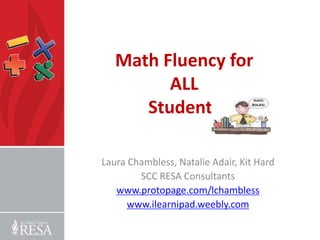
Math fluency for all students ppt
- 1. Math Fluency for ALL Students Laura Chambless, Natalie Adair, Kit Hard SCC RESA Consultants www.protopage.com/lchambless www.ilearnipad.weebly.com
- 2. Learning Target I can reach all learners, through engaging activities, while knowing which phase (counting, reasoning, and retrieval) students are in to build basic math fact fluency.
- 3. Goal Fluency is being misrepresented through the use of "timed- tests". We do not want teachers focusing on how fast students can solve a list of math problems versus developing a strong understanding of number sense. Teaching them will requires more than flash cards and timed test.
- 4. What are basic facts? When addends or factors are less than 10
- 5. Facts by Grade Level Grade CCSS Required Fluency K Add/subtract within 5 1 Add/subtract within 10 2 Add/subtract within 20 (know from memory all sums of two one-digit numbers) Add/subtract within 1000 3 Multiply/divide within 100 (know from memory all products of two one-digit numbers) Add/subtract within 1,000 4 Add/subtract within 1,000,000 5 Multi-digit multiplication 6 Multi-digit division Multi-digit decimal operations
- 6. Mastery of Basic Facts “Fluency” “Mastery of a basic fact means that a child can give a quick response (in about 3 seconds) without resorting to non-efficient means, such as counting.” From: NCTM’s Curriculum Focal Points “Fluency with basic facts is the efficient, appropriate, and flexible application of single-digit calculations skills and is an essential aspect of Mathematical proficiency.” From: Baroody, (2006) article from Teaching Children Mathematics
- 7. CCSS different from GLCEs The CCSS takes the approach of understanding there are phases students progress through as they learn their basic facts. CCSS Words: using strategies, fluency, know from memory
- 8. Phases Phase Description 1 Counting Modeling and/or counting to find the answer 2 Reasoning Deriving answers using reasoning strategies based on known facts 3 Retrieval Mastery: efficient production of answers Each phase needs to have substantial meaningful practice and emphasize “thinking strategies”. This approach allows computation and understanding to develop.
- 9. Time Meaningful practice takes time! It takes between 2 to 4 lessons before most students internalize the a strategies discussed in class.
- 10. Addition Strategies • Number After rule (n+1) • Count on 2 or 3 • Doubles • Near Doubles – Doubles plus 1 – Doubles plus 2 • Make Ten • Turn Around Facts • Zero Property • Nines – add ten then subtract 1
- 11. Subtraction Strategies • Count Back • Count Up – think addition • Doubles • Zero Property • Related Facts
- 12. Multiplication Strategies Number Definition x0 Any number times zero is zero x1 Any number times 1 is itself x2 Doubles – skip count by 2’s – all the even numbers x3 1. Skip count by 3’s or 2. Double the other factor and then add it in one more time x4 Double doubles x5 Times 10, then half x6,7,8 Many of these are found by the commutative property Nifty 1. The tens digit of the product is one less than the Nines “other” factor (4x9=36) 2. The sum of the two digits in the product is always nine. (9x8=72… 7+2=9) Squares Fun to remember
- 13. Division Strategies • Division as Think Multiplication • 2s,4s,8s: Use halving rule Multiplication Fact Posters & Division Fact Posters http://www2.carrollk12.org/instruction/elemcurric/math/tba sicfacts.HTM
- 14. Daily Instruction • After initial class lessons on specific strategies • Use activities to guide students through phase 1 and 2 and into phase 3 • 5 – 10 minutes a day Five A Day http://www2.carrollk12.org/instruction/elemcurric/ math/tbasicfacts.HTM
- 15. Phase 1 Activities (Counting) Addition/Subtraction • Addition – One More Than and Two More Than with Dice and Spinner (Van De Walle) – Pick Two Numbers: Math Mountains with Tiny Tumblers (Singapore/Math Expression) – Ten Friend Game using Ten Frames • Subtraction – Ten Frame Subtracting (Carroll County Schools) http://www2.carrollk12.org/instruction/elemcurric/math/tbasicfacts.HTM – Ten Partner Subtraction – Pick Two Numbers:Math Mountains with Tiny Tumblers (Singapore/Math Expression
- 16. Phase 1 Activities (Counting) Multiplication/Division • Multiplication – Clock Facts (Van De Walle) – Yay For Arrays! (E is for Explore!) – Explore Multiplication (E is for Explore!) • Division – Yay For Arrays! For Division – Dot Array Fact Families(Numbered Heads Together)
- 17. Learning Target I can reach all learners, through engaging activities, while knowing which phase (counting, reasoning, and retrieval) students are in to build basic math fact fluency.
- 18. Session 2
- 19. Phase 2 Activities Add/Sub Strategies • Addition • Subtraction
- 20. Phase 2 Activities Multi/Divide Strategies • Multiplication • Division